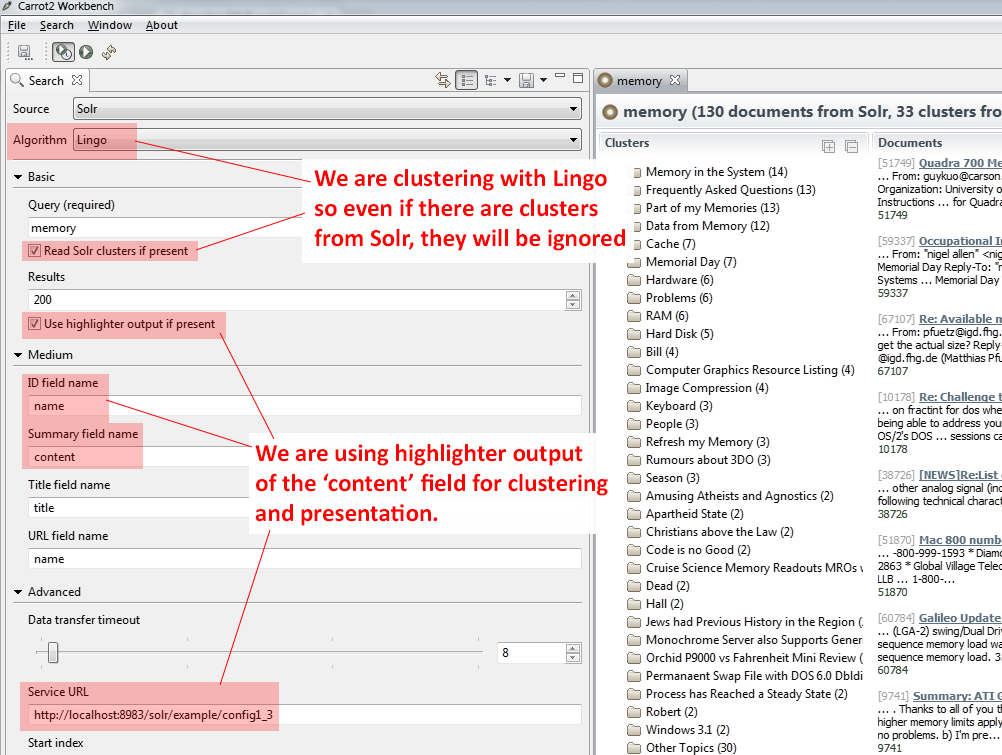Apache SOLR and Carrot2 integration strategies
Carrot2 3.7.0, Solr 4.2.1
Adding clustering of search results to Apache Solr can be done in several ways, depending on where the clustering takes place, which fields are picked for clustering and how they are transformed before they are clustered. This document discusses several of these strategies.
Preparations
The following github repository contains code samples and configurations used in the remaining part of this document.
git clone https://github.com/carrot2/solr-integration-strategies.git
A local copy of Solr 4.2.1 will be required.
cd solr-integration-strategies
cd carrot2-3.7.0/
wget -c -t0 -T30 http://www.us.apache.org/dist/lucene/solr/4.2.1/solr-4.2.1.tgz
tar -zxf solr-4.2.1.tgz
This example contains a demo Solr configuration (including data schema) and some sample documents from the 20-newsgroups collection. The following command starts Solr and imports these documents. Solr should be started from another shell session since it won't return to shell.
cd solr-4.*
cd example
java -Dsolr.solr.home=../../solr-home -jar start.jar
Once started, the search core should be visible in the administrative panel at http://localhost:8983/solr/#/example.
To import example documents execute the following commands from top-level repository checkout folder:
cd solr-docs
java -jar post.jar 20newsgroups
An overview of Solr and Carrot2 configurations
There are several axes which diversify the configuration of Solr and Carrot2:
- Where does clustering take place (inside Solr or outside Solr)?
- What data is fed into the clustering process (entire contents of stored fields, query-in-context snippets)?
- Are users experimenting with clustering parameters or is clustering preset on the server for all users? For example the web application front-end to clustered search results will be shared by all users, whereas users of Carrot2 Workbench will need a raw stream of search results which is then clustered on their machine.
All examples in this chapter assume a certain fixed choice in the above set of configuration options. Pick the one closest to your own.
Clustering inside Solr, entire fields
This configuration clusters the selected fields of Solr documents returned for a given query on Solr side, as shown in the figure below.

We will consider a few variants of this configuration in which either full content of fields or just their fragments are used for clustering.
- Solr setup (JAR dependencies)
-
Modify
solrconfig.xml. Include Carrot2 JARs distributed with Solr and any other JARs needed for clustering algorithms (if using Lingo3G, for example). Note that the paths provided tolibare resolved relative to the core's directory (unless they are absolute). This can be tricky. For our layout the configuration is:<lib dir="../../solr-4.2.1/contrib/clustering/lib/" regex=".*\.jar"></lib> <lib dir="../../solr-4.2.1/dist/" regex=".*solr-clustering-.*\.jar"></lib> - Solr setup (search component)
-
Configure a
searchComponentwhich does the actual clustering. Solr's wiki has detailed instructions covering all options. For this example we will configure a single search component with one algorithm (the open source Lingo).<searchComponent name="clustering" enable="true" class="solr.clustering.ClusteringComponent"> <lst name="engine"> <str name="name">default</str> <str name="carrot.algorithm">org.carrot2.clustering.lingo.LingoClusteringAlgorithm</str> <str name="LingoClusteringAlgorithm.desiredClusterCountBase">20</str> <str name="carrot.lexicalResourcesDir">clustering/carrot2</str> <str name="MultilingualClustering.defaultLanguage">ENGLISH</str> </lst> </searchComponent> - Solr setup (search handler)
-
Once we have a clustering search component we can create a handler that will cluster search results. In this configuration all fields of matching documents are returned, followed by information about clusters.
<requestHandler name="/config1_1" class="solr.SearchHandler"> <lst name="defaults"> <str name="defType">edismax</str> <str name="qf"> title^1.5 content^1.0 </str> <str name="rows">100</str> <str name="fl">*,score</str> <!-- Enable clustering. --> <bool name="clustering">true</bool> <!-- enable clustering --> <bool name="clustering.results">true</bool> <!-- cluster search results, not the collection --> <str name="clustering.engine">default</str> <!-- use the default engine --> <!-- Solr-to-Carrot2 field mapping. --> <str name="carrot.url">name</str> <!-- unique ID field, doesn't have to be an URL --> <str name="carrot.title">title</str> <!-- document title field. --> <str name="carrot.snippet">content</str> <!-- document "contents" field --> </lst> <!-- Attach clustering as the last processing component. --> <arr name="last-components"> <str>clustering</str> </arr> </requestHandler>Note the mapping between Solr document's fields and "logical" document sections requried by Carrot2. The
carrot.urlfield must be something unique because clusters in the response are referenced by this identifier. Also note the default number of search results to retrieve is 100. Clustering search results will be meaningful if more than 100 documents are available to the algorithm. This does add up to each query's cost on Solr, in addition to the clustering itself.A query sent to this handler will fetch a large file, we will try to do something with this in the next section:
wget -q -O - "http://localhost:8983/solr/example/config1_1?q=memory&wt=xml&indent=true" | wc -c 858190 - Solr setup (search handler returning a subset of fields)
-
The problem is that the response contains
contentfield which is large. We can restrict the result to only containnameandtitleby modifying theflparameter. Note that clustering will still fetch the entirecontentfield internally so this does not affect clusters. Actually, if only the clusters are needed one could restrict the fields to just the ID field (namein this example).<!-- Restrict the returned fields to just the name and title. contents can be too large to display anyway. --> <str name="fl">name,title,score</str>This results in an much smaller response:
wget -q -O - "http://localhost:8983/solr/example/config1_2?q=memory&wt=xml&indent=true" | wc -c 22895 - Solr setup (search handler returning contextual snippets)
-
If the response documents should be displayed (and contain clusters as well) then the middle ground between skipping fields and returning full fields is to use the highlighter to display a contextual fragment of the field around the search hit. This limits the size of the response and allows some insight into the document. Clusters are unaffected in this configuration (full content field is still clustered).
<requestHandler name="/config1_3" class="solr.SearchHandler"> <lst name="defaults"> <str name="defType">edismax</str> <str name="qf"> title^1.5 content^1.0 </str> <str name="rows">100</str> <str name="fl">name,title,score</str> <!-- Enable highlighter for the content field --> <bool name="hl">true</bool> <str name="hl.fl">content</str> <!-- Disable highlight wrapping. --> <str name="hl.simple.pre"><!-- --></str> <str name="hl.simple.post"><!-- --></str> <str name="f.content.hl.snippets">3</str> <!-- max 3 snippets of 200 chars. --> <str name="f.content.hl.fragsize">200</str> <bool name="clustering">true</bool> <bool name="clustering.results">true</bool> <str name="clustering.engine">default</str> <str name="carrot.url">name</str> <str name="carrot.title">title</str> <str name="carrot.snippet">content</str> </lst> <arr name="last-components"> <str>clustering</str> </arr> </requestHandler>The output of this handler contains the snippets and clusters created on top of full field contents.
wget -q -O - "http://localhost:8983/solr/example/config1_3?q=memory&wt=xml&indent=true" | wc -c 65700
Clustering inside Solr, query-in-context fragments
This configuration is similar to clustering full fields inside Solr but takes only a certain number of text fragments around search matches. Doing so, perhaps contrary to the intuition, has several benefits:
- increased speed of clustering due to smaller amount of data fed to the algorithm,
- more query-focused clusters due to the fact that the text around the search matches is typically closely related to the query itself.
The initial configuration setup (JARs, search components) is identical to the one shown in previous configurations. We will focus on search handlers only.
- Solr setup (search handler clustering query-in-context snippets)
-
To configure clustering to use query-in-context snippets instead of full field content, pass
carrot.produceSummaryattribute in Solr's handler configuration, as shown below:<requestHandler name="/config2_1" class="solr.SearchHandler"> <lst name="defaults"> <str name="defType">edismax</str> <str name="qf"> title^1.5 content^1.0 </str> <str name="rows">100</str> <str name="fl">name,title,score</str> <bool name="clustering">true</bool> <bool name="clustering.results">true</bool> <str name="clustering.engine">default</str> <!-- field mapping --> <str name="carrot.url">name</str> <str name="carrot.title">title</str> <str name="carrot.snippet">content</str> <!-- enable clustering on highlighted fragments only. --> <str name="carrot.produceSummary">true</str> <!-- take a max. of 3 fragments from each document's match. --> <str name="carrot.summarySnippets">3</str> </lst> <arr name="last-components"> <str>clustering</str> </arr> </requestHandler>Compare the difference in processing time (
QTime) on the server for the configuration returning the same fields but clustering fullcontentfield:INFO: [example] webapp=/solr path=/config1_2 params={indent=true&q=memory&wt=xml} hits=130 status=0 QTime=987 INFO: [example] webapp=/solr path=/config1_2 params={indent=true&q=memory&wt=xml} hits=130 status=0 QTime=973 INFO: [example] webapp=/solr path=/config1_2 params={indent=true&q=memory&wt=xml} hits=130 status=0 QTime=959and just the snippets from
contentortitle:INFO: [example] webapp=/solr path=/config2_1 params={indent=true&q=memory&wt=xml} hits=130 status=0 QTime=272 INFO: [example] webapp=/solr path=/config2_1 params={indent=true&q=memory&wt=xml} hits=130 status=0 QTime=230 INFO: [example] webapp=/solr path=/config2_1 params={indent=true&q=memory&wt=xml} hits=130 status=0 QTime=199For larger fields the difference would be even more pronounced.
Note: The set of clusters returned from full-field clustering will be different than that returned from clustering based on fragments. This is natural as the clustering algorithm "sees" a different aspect of the input and produces a different categorization. Consider a human presented with 100 documents -- he or she would categorize them differently if taken as a whole, compared to the situation when only an excerpt of a specific context is provided.Note that clustering and highlighter fragments are independent so it's possible to use both at the same time, as shown below.
<requestHandler name="/config2_2" class="solr.SearchHandler"> <lst name="defaults"> <str name="defType">edismax</str> <str name="qf"> title^1.5 content^1.0 </str> <str name="rows">100</str> <str name="fl">name,title,score</str> <!-- Enable highlighter for the content field --> <bool name="hl">true</bool> <str name="hl.fl">content</str> <!-- Disable highlight wrapping. --> <str name="hl.simple.pre"><!-- --></str> <str name="hl.simple.post"><!-- --></str> <str name="f.content.hl.snippets">3</str> <!-- max 3 snippets of 200 chars. --> <str name="f.content.hl.fragsize">200</str> <bool name="clustering">true</bool> <bool name="clustering.results">true</bool> <str name="clustering.engine">default</str> <!-- field mapping --> <str name="carrot.url">name</str> <str name="carrot.title">title</str> <str name="carrot.snippet">content</str> <!-- enable clustering on highlighted fragments only. --> <str name="carrot.produceSummary">true</str> <!-- take a max. of 3 fragments from each document's match. --> <str name="carrot.summarySnippets">3</str> </lst> <arr name="last-components"> <str>clustering</str> </arr> </requestHandler>
Displaying Solr-clustered results in Carrot2 webapp and Workbench
Typically, the clustering process would take place outside of Solr, on a dedicated Carrot2 webapp server or proxy, as shown below.

When using the clustering Workbench, clustering takes place on the user side:
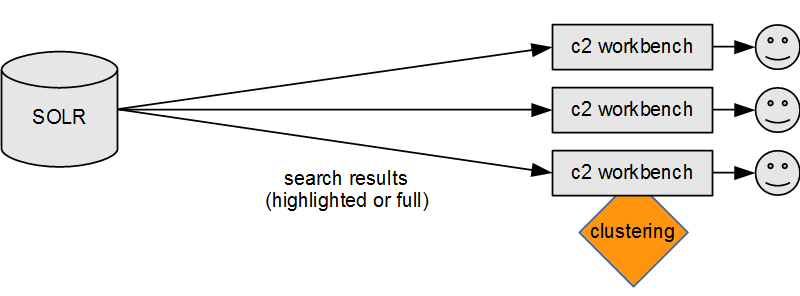
Even though not designed for such a use case, Carrot2's
web application and the Workbench can serve as front-ends
for Solr-clustered search results. Starting with version 3.7.0,
SolrDocumentSource can be told to fetch clusters produced by Solr and optionally use
the highlighter's output. For versions prior to 3.7.0, a custom XSLT
transformation stylesheet combined with XmlDocumentSource needs to be used
(see here).
Such a configuration will correspond to the following diagram:

And the Workbench will connect to Solr directly as well:

A screenshot with Workbench configuration to access clusters in
our example's /config2_2 looks as shown below. Note the output
in the screenshot is hierarchical -- this is so because Lingo3G
(a commercial algorithm plugging into the Carrot2 framework) was
used for its preparation. Solr configuration was identical except for the clustering implementation
name passed via carrot.algorithm parameter.
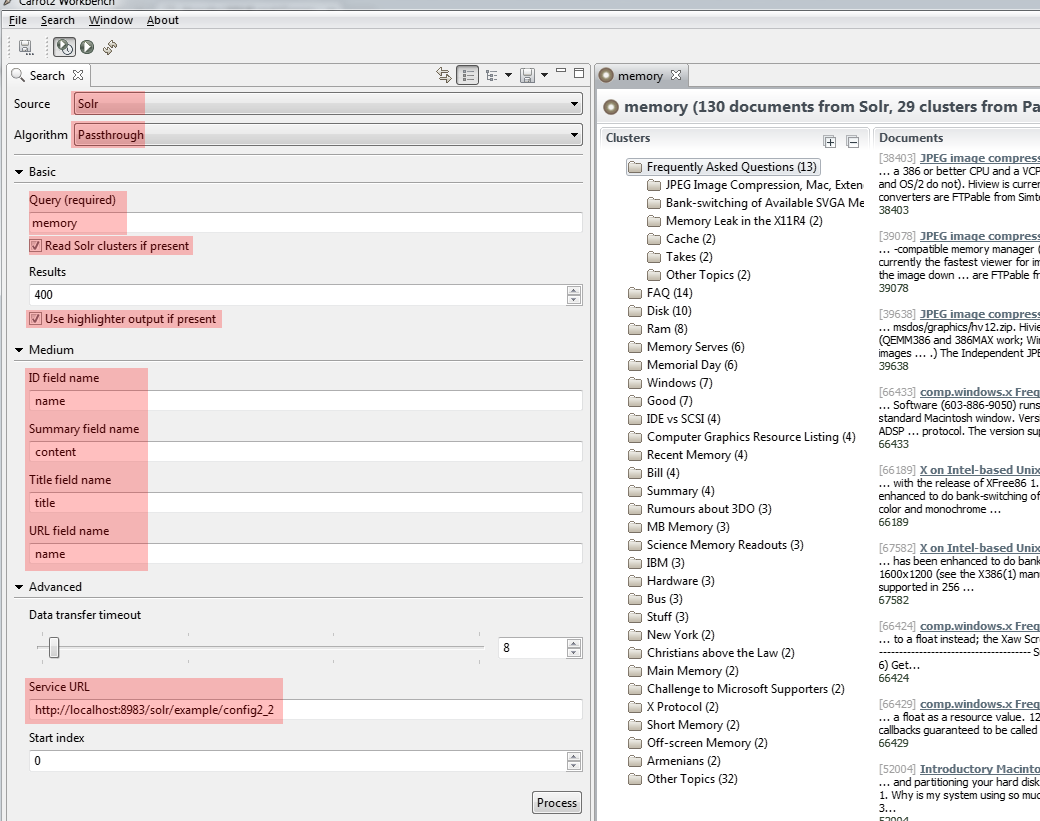
The webapp can be configured to proxy Solr clusterer's output in a similar fashion simply
by adjusting the default attributes configuring SolrDocumentSource.
Start by fetching the WAR file of the webapp:
wget http://download.carrot2.org/stable/3.7.0/carrot2-webapp-3.7.0.war
unzip -d carrot2-webapp carrot2-webapp-3.7.0.war
cd carrot2-webapp/WEB-INF/suites
vi suite-webapp.xml
Edit suite-webapp.xml to point at the Solr instance and contain just the pass-through algorithm.
<component-suite>
<sources>
<source component-class="org.carrot2.source.solr.SolrDocumentSource" id="solr" attribute-sets-resource="source-solr-attributes.xml">
<label>Solr</label>
<title>Solr Search Engine</title>
<icon-path>icons/solr.png</icon-path>
<mnemonic>s</mnemonic>
<description>Solr document source queries an instance of Apache Solr search engine.</description>
<example-queries>
<example-query>test</example-query>
<example-query>solr</example-query>
</example-queries>
</source>
</sources>
<!-- Algorithms -->
<include suite="algorithm-passthrough.xml"></include>
</component-suite>
The address and remaining attributes of Solr need to be placed into source-solr-attributes.xml.
<attribute-sets default="overridden-attributes">
<attribute-set id="overridden-attributes">
<value-set>
<label>overridden-attributes</label>
<attribute key="SolrDocumentSource.serviceUrlBase">
<value value="http://localhost:8983/solr/example/config2_2"/>
</attribute>
<attribute key="SolrDocumentSource.solrSummaryFieldName">
<value value="content"/>
</attribute>
<attribute key="SolrDocumentSource.solrTitleFieldName">
<value value="title"/>
</attribute>
<attribute key="SolrDocumentSource.solrUrlFieldName">
<value value="name"/>
</attribute>
<!-- Proxy clusters from Solr. Link on 'name' field. -->
<attribute key="SolrDocumentSource.solrIdFieldName">
<value value="name"/>
</attribute>
<attribute key="SolrDocumentSource.readClusters">
<value value="true"/>
</attribute>
</value-set>
</attribute-set>
</attribute-sets>
Note that the default Carrot2 interface exposes customizable document source attributes, which may be a security problem in real deployments. We strongly encourage you to fork the default web application and tailor it to your needs in such cases.
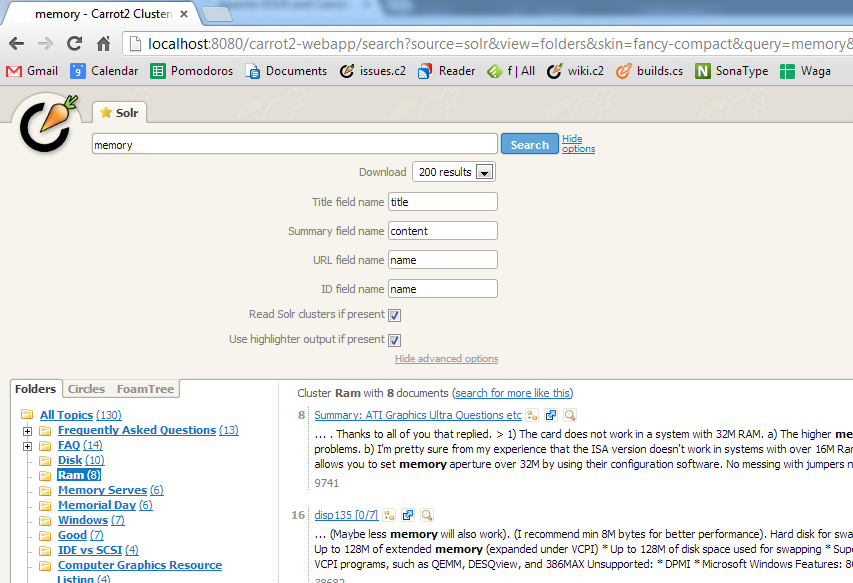
Clustering of entire fields outside Solr
We have already visited this setup when talking about connecting Workbench to display Solr's clusters:

This is pretty much what SolrDocumentSource does by default. You just need to map
Carrot2 logical document sections (title, snippet, url) to Solr's schema and make sure
the handler returns those fields as described when discussing different handler
configurations above.
Note that full fields clustering outside Solr may incur large network overhead penalty associated with fetching long fields over the network and may result in odd-looking long snippets if stored Solr fields are lengthy. For Workbench this can be tuned inside preferences, as shown below.
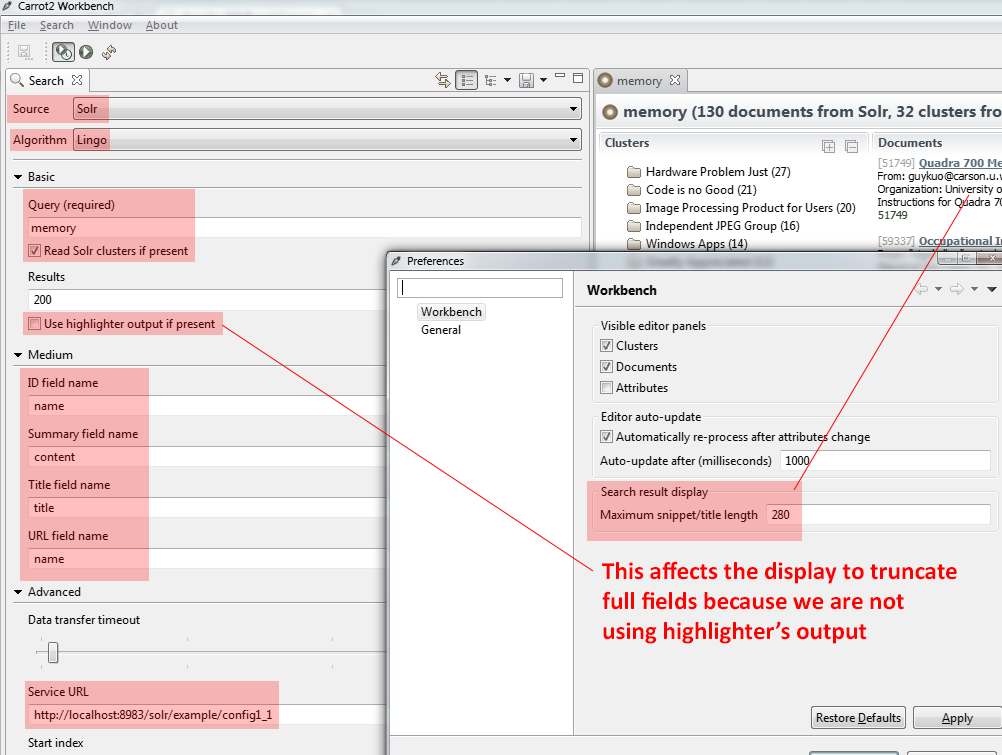
Clustering of query-in-context fragments outside Solr
Alternatively to returning and clustering full fields, starting from version
3.7.0 SolrDocumentSource can use highlighter
fragments if they are available in Solr's response.
